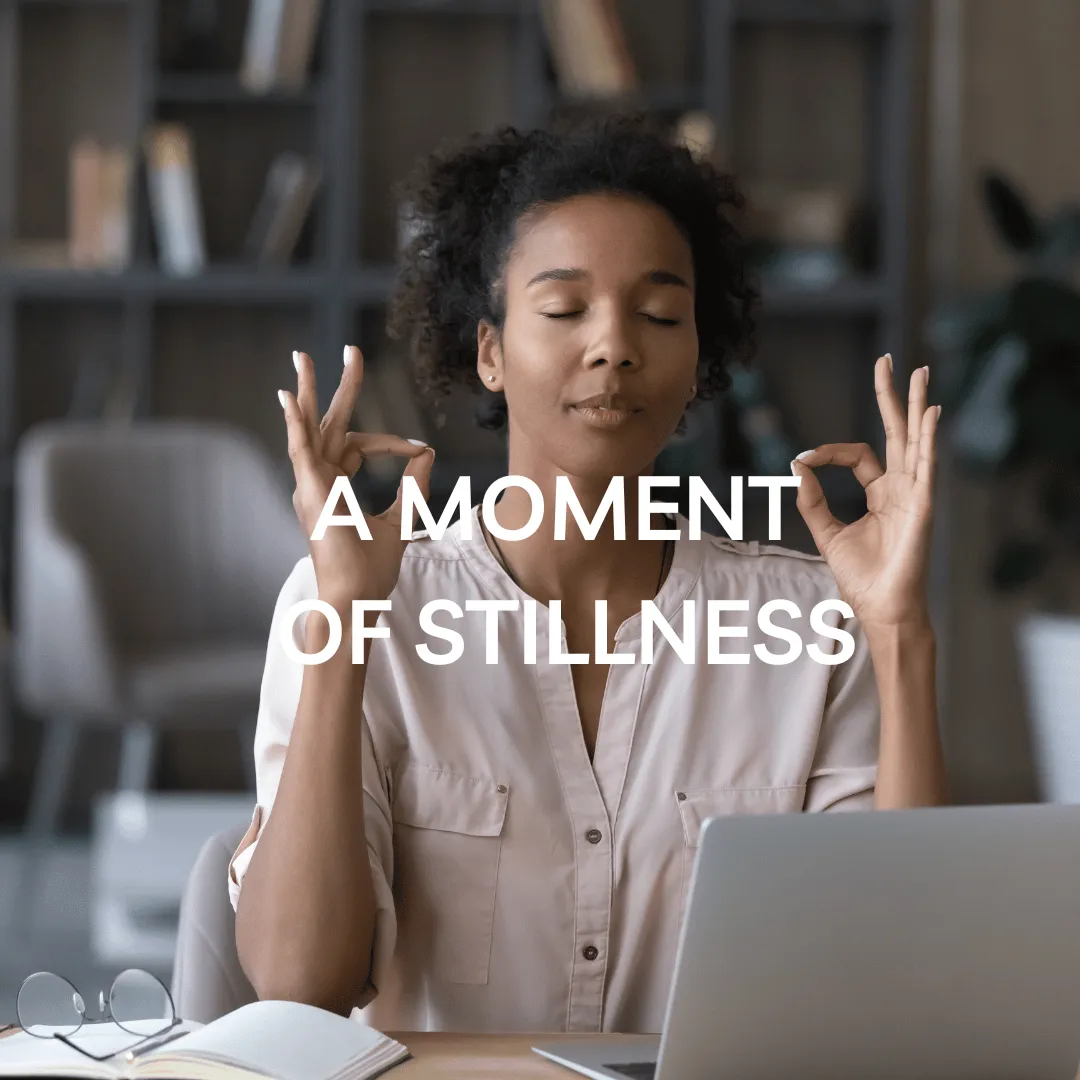
Top Tips to Manage Stress and Anxiety in the Workplace and Avoid Burnout

Our Top Five Tips to Manage Stress and Anxiety in the Workplace and Avoid Burnout
Let's face it: today's fast-paced work environment can lead to stress and anxiety, and it's become all too common. When left unchecked, it can lead to burnout!
Our emotional, physical, and mental exhaustion that impacts productivity, morale, and overall well-being all suffer, and how we work is also affected. Nobody wants to burn out and feel like this; we have some solutions for you!
At Sanctuary Wellness, we believe that using these strategies can help you stay balanced and resilient, even when working under pressure. Here are our top tips for managing stress and anxiety in the workplace and preventing burnout.
1. Prioritise Regular Breaks
Taking micro-breaks throughout the working day has been linked to reducing fatigue and improving stamina while working at your desk. Taking short, regular breaks throughout the workday is essential for maintaining focus and avoiding mental fatigue (Albulescu et al., 2022). Why not take a quick walk, do chair yoga while sitting at your desk, or even step away from your desk for five minutes? All of these can help reset your mind and recharge your energy.
Why not encourage your team to adopt the "Pomodoro Technique", setting a timer to work in focused 25-minute intervals followed by a 5-minute break? This will help maintain productivity while allowing for regular mental rest.

2. Cultivate a Mindful Workspace
Mindfulness is a powerful tool for managing stress and anxiety. It can help us remain present and calm, even when working in high-pressure situations.
A systematic review found mindfulness-based interventions (MBIs) effectively reduced physiological stress markers, including cortisol levels and heart rate variability. These interventions also improved autonomic balance, suggesting their role in reducing stress-related physical symptoms (Heckenberg et al., 2018).
Techniques like deep breathing, meditation, or simply pausing to focus on the present moment can reduce stress and improve clarity.
Try to incorporate mindfulness breaks into your and your team’s daily routine.
Even a 5-minute guided meditation can make a big difference in stress levels. Click here to access free guided meditations to help you find a moment of calm so you can get on with your day feeling grounded and present.

3. Open Communication in the Workplace
Transformational and transactional leadership styles are associated with higher well-being scores among employees, while destructive leadership styles contribute to increased stress and reduced mental health, as well as having a supportive workplace (Erschens et al., 2022). Chen & Qiwei Luna Wu, (2023) Discuss how management teams and executive leaders who model health-promoting behaviours help build a supportive workplace environment and a culture where employees feel comfortable expressing concerns, which reduces stress and improves productivity.
Promoting psychological safety through open communication and mutual respect is essential for reducing stress, anxiety and burnout among team members, especially among vulnerable employees with chronic illnesses (Kirk-Brown & Van Dijk, 2015). Having authentic leadership styles that are characterised by openness and vulnerability encourages employees to adopt proactive coping strategies, reducing psychological vulnerability and stress (Dedi Hadian et al., 2022).
Regular check-ins and open conversations about workloads, challenges, and goals can prevent feelings of isolation and overwhelm. Leaders and management teams can model vulnerability by sharing their stress management techniques and encouraging team members to do the same. Health-oriented leadership communication positively influences employees’ self-care and reduces stress levels.

4. Encourage Physical Activity
Exercise is a proven way to reduce anxiety and boost mood. Programs incorporating yoga, circuit training, or brisk walking during work hours improved mental health parameters like depression, anxiety, and stress, as well as physical health markers such as body composition and fitness (Laux et al., 2020).
Incorporating physical activity into the workday, whether through group fitness classes, walking meetings, or standing desks, can help employees release tension and stay energised. Lunchtime walking programs increased employee relaxation, enthusiasm, and overall mood, showing how integrating movement into the workday can positively influence affect and energy levels.
Yoga interventions effectively reduced stress, anxiety, and depression while improving resilience and emotional well-being in employees. Even short programs (e.g., weekly one-hour sessions for six weeks) yielded significant benefits (Hartfiel et al., 2010). Studies have shown that yoga elevates brain GABA levels (linked to mood regulation), resulting in reduced anxiety and improved mood, outperforming other forms of physical activity like walking in some measures (Streeter et al., 2010).
Calogiuri et al, (2015) discuss that encouraging your team to go outside for a lunchtime walk or exercise outdoors in natural settings ("green exercise") provided restorative benefits, reducing stress and enhancing positive emotions compared to indoor physical activities.
Why not host a weekly yoga session (in-person or virtual) to move a regular part of your workplace culture? Click here to discuss how we can help you achieve work-life balance in your company.

5. Promote Work-Life Balance
Blurred boundaries between work and personal life heighten work-related stress and burnout. Providing flexible work options and promoting downtime are critical strategies for reducing burnout and improving well-being (Joel Bulus Haruna, 2023).
Burnout often stems from blurred boundaries between work and personal life.
Encouraging employees to disconnect after work hours, take annual leave, and set realistic expectations around workload, especially in a work-from-home environment, will help prevent burnout (Sahbudin Shaari & Sharifah Milda Amirul, 2023). Allowing employees to adjust their schedules and take time off when needed is associated with lower job stress, reduced activity limitations, and higher job satisfaction.
Flexibility in work hours is linked to reduced stress, improved mental health, and enhanced work-life balance. Employees with control over their schedules experience lower work-life conflict and better overall health. Flexible working arrangements, such as flexitime and hybrid working, improve employee well-being, work-life balance, and job satisfaction. Flexitime schedules particularly reduce stress and role overload (Ray & Cryan, 2021).
Mwangi, (2016) discuses that organisations who implement work-life balance initiatives, including flexible work arrangements and well-being days, report increased employee loyalty and productivity and reduced burnout.
Offer flexible working options or well-being days to allow employees to recharge and maintain balance. Why not ask our team how we can help create well-being days that prevent burnout and promote positive work-life balance? Click here.

We know that stress and anxiety may be unavoidable in the workplace, but burnout doesn’t have to be. When we start implementing strategies thaty prevent burnout, organisations can create cultures that supports mental health and boosts resilience, helping teams thrive personally and professionally.
At Sanctuary Wellness, we support you with tailored well-being programmes designed to make lasting positive changes in your workplace.
Speak to our team today so we can discuss how our well-being packages can help you promote positive cultures and prevent burnout even in the most stressful situations.
Click here to schedule a meeting.
References
Albulescu, P., Macsinga, I., Rusu, A., Sulea, C., Bodnaru, A., & Tulbure, B. T. (2022). “Give me a break!” A systematic review and meta-analysis on the efficacy of micro-breaks for increasing well-being and performance. PLOS ONE, 17(8). https://doi.org/10.1371/journal.pone.0272460
Calogiuri, G., Evensen, K., Weydahl, A., Andersson, K., Patil, G., Ihlebæk, C., & Raanaas, R. K. (2015). Green exercise as a workplace intervention to reduce job stress. Results from a pilot study. Work, 53(1), 99–111. https://doi.org/10.3233/wor-152219
Chen, F., & Qiwei Luna Wu. (2023). Health-oriented leadership communication matters: a trickle-down model to enhance employees’ health and well-being during turbulent times. Corporate Communications: An International Journal, 29(3). https://doi.org/10.1108/ccij-03-2023-0029
Dedi Hadian, Dudung Juhana, Soelaiman Sukmalana, Aan Hardiyana, Maulana Yusup, Iwan Sidharta, Adhie Fasha Nurhadian, & Nenny Rinawati. (2022). Authentic Leadership on Employee Coping and Its Impact on Psychological Vulnerable: Survey on Public Organization in Bandung, Indonesia. Academic Journal of Interdisciplinary Studies, 11(5), 139–139. https://doi.org/10.36941/ajis-2022-0131
Erschens, R., Seifried-Dübon, T., Stuber, F., Rieger, M. A., Zipfel, S., Nikendei, C., Genrich, M., Angerer, P., Maatouk, I., Gündel, H., Rothermund, E., Peters, M., & Junne, F. (2022). The association of perceived leadership style and subjective well-being of employees in a tertiary hospital in Germany. PLOS ONE, 17(12), e0278597. https://doi.org/10.1371/journal.pone.0278597
Hartfiel, N., Havenhand, J., Khalsa, S. B., Clarke, G., & Krayer, A. (2010). The effectiveness of yoga for the improvement of well-being and resilience to stress in the workplace. Scandinavian Journal of Work, Environment & Health, 37(1), 70–76. https://doi.org/10.5271/sjweh.2916
Hayman, J. (2018). Flexible Work Schedules and Employee Well-being. New Zealand Journal of Employment Relations. https://www.semanticscholar.org/paper/Flexible-Work-Schedules-and-Employee-Well-being-Hayman/b177e225d41289e8b9bef195e38b9dbb1c883e87?
Heckenberg, R. A., Eddy, P., Kent, S., & Wright, B. J. (2018). Do workplace-based mindfulness meditation programs improve physiological indices of stress? A systematic review and meta-analysis. Journal of Psychosomatic Research, 114(2018), 62–71. https://doi.org/10.1016/j.jpsychores.2018.09.010
Joel Bulus Haruna. (2023). Stress and Burnout in the Workplace. International Journal for Research in Applied Science and Engineering Technology, 11(10), 800–801. https://doi.org/10.22214/ijraset.2023.56088
Kirk-Brown, A., & Van Dijk, P. (2015). An examination of the role of psychological safety in the relationship between job resources, affective commitment and turnover intentions of Australian employees with chronic illness. The International Journal of Human Resource Management, 27(14), 1626–1641. https://doi.org/10.1080/09585192.2015.1053964
Laux, R. C., Filippini Tabela, B. A., Antonio, D. S., & Zanini, D. (2020). Effect of a session of the workplace physical activity program on mood. International Physical Medicine & Rehabilitation Journal, 5(4), 141–145. https://doi.org/10.15406/ipmrj.2020.05.00247
Mwangi, R. G. (2016). INFLUENCE OF WORK-LIFE BALANCE ON EMPLOYEE PRODUCTIVITY IN GOVERNMENT INSTITUTIONS: A CASE OF THE SUPREME COURT, NAIROBI. Strategic Journal of Business & Change Management, 3(4). https://strategicjournals.com/index.php/journal/article/view/343
Ray, T. K., & Cryan, R. P. (2021). Work Flexibility and Work-Related Well-Being. International Journal of Environmental Research and Public Health, 18(6), 3254. NCBI. https://www.ncbi.nlm.nih.gov/pmc/articles/PMC8004082/
Saavedra, J., Kristjánsdóttir, H., Gunnarsson, S., & García-Hermoso, A. (2021). Effects of 2 physical exercise programs (circuit training and brisk walk) carried out during working hours on multidimensional components of workers’ health: a pilot study. International Journal of Occupational Medicine and Environmental Health, 34(1), 39–51. https://doi.org/10.13075/ijomeh.1896.01647
Sahbudin Shaari, & Sharifah Milda Amirul. (2023). Flexible Working Arrangements (FWAs) in Malaysia: The Missing Component of the Right to Disconnect. IOP Conference Series, 1181(1), 012013–012013. https://doi.org/10.1088/1755-1315/1181/1/012013
Streeter, C. C., Whitfield, T. H., Owen, L., Rein, T., Karri, S. K., Yakhkind, A., Perlmutter, R., Prescot, A., Renshaw, P. F., Ciraulo, D. A., & Jensen, J. E. (2010). Effects of Yoga Versus Walking on Mood, Anxiety, and Brain GABA Levels: A Randomized Controlled MRS Study. The Journal of Alternative and Complementary Medicine, 16(11), 1145–1152. https://doi.org/10.1089/acm.2010.0007